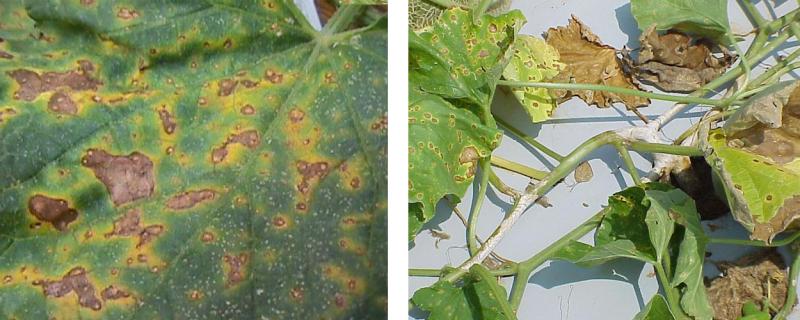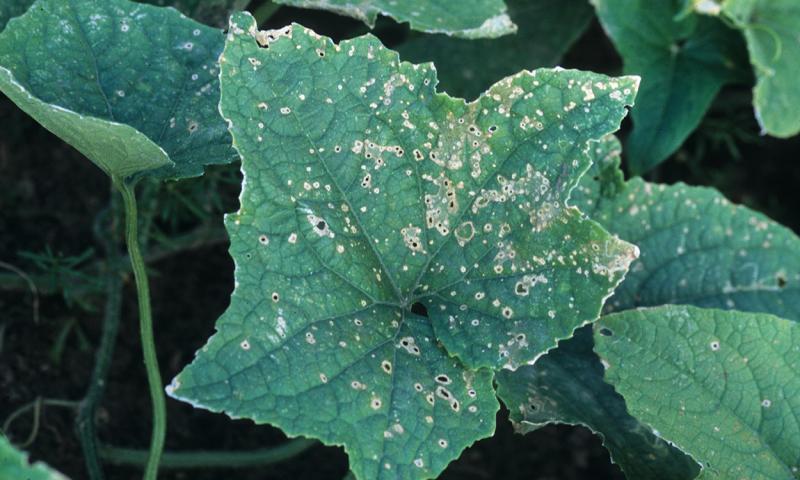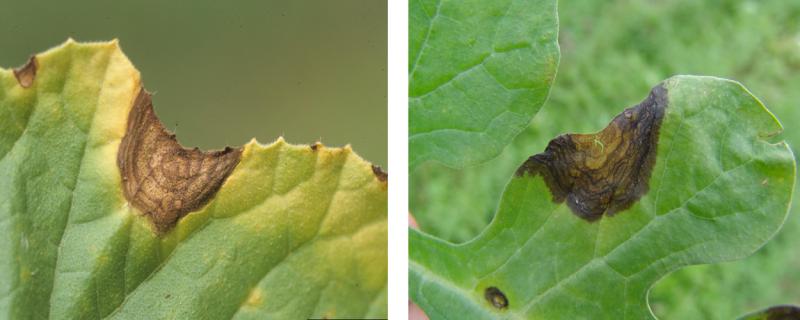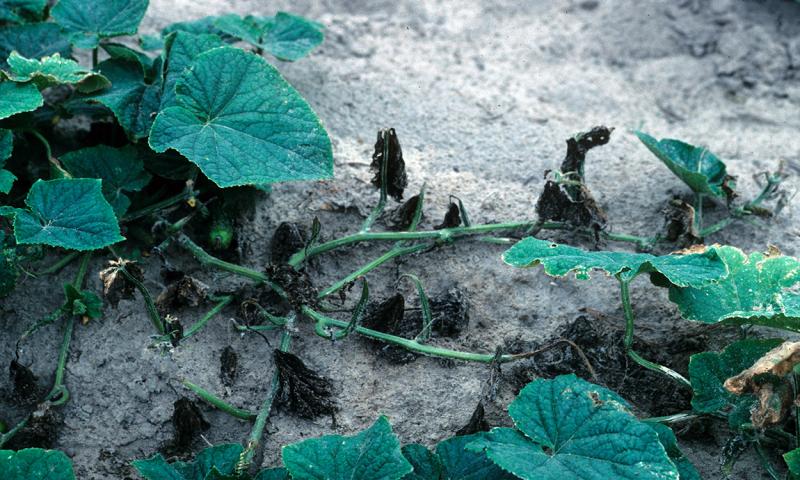Written collaboratively by Madalyn Shires, Kristine Lang, and Sean Toporek.
Introduction
Cucurbits are one of the most-popular specialty crops grown in South Dakota. While these plants produce a large variety of produce, they also struggle with many disease pressures that can be economically devastating. Cucurbits grown in both the field and in high tunnels face disease pressure from many fungal and bacterial diseases. The most-common diseases found in 2023 that affected cucurbits are Alternaria, Anthracnose, Gummy Stem Blight, and Bacterial Wilt.
Disease Quick Facts
Alternaria Leaf Spot
This is a fungal pathogen that is problematic on a wide range of hosts, from vegetables to trees and row crops. This has been the most-reported fungal disease of cucurbits this year, especially in high tunnel operations. Disease development is favored by temperatures ranging from 70 to 90 degrees Fahrenheit, humidity, and overhead watering, as this allows for splashing of fungal spores.

Symptoms include brown, concentric rings on leaves that develop a yellow halo. The spots may appear fuzzy with spore production. This disease can also cause symptoms on fruit in severe infections. As the infection progresses, the entire plant will begin to turn necrotic and eventually die, causing large yield losses.
Management for this disease includes crop rotation, residue management, irrigation management, and utilizing resistant varieties. Alternaria survives on plant residues and will continue the infection cycle throughout the season, as well as into the next growing season, if inoculum is not removed. Rotation away from non-host crops and tillage can help lessen fungal spores. Utilizing irrigation systems that do not cause water splash, such as drip tape, can also help reduce desirable environmental conditions for disease development. There are limited chemical controls that can be utilized; if this option is selected, be sure to read and understand labeling recommendations.
Anthracnose of Cucurbits
Similar to Alternaria, Anthracnose is a very common fungal disease on a range of crops in South Dakota. This disease varies in severity from visually bothersome to economically devastating. Disease development is favored by warm and moist environmental conditions.

Symptomology of this disease varies, depending on the specific cucurbit that is affected. The most-common symptom is a brown leaf spot that the centers eventually drop out of (shot holes). Fruit symptoms are black, slightly sunken spots. Affected plants can become very symptomatic and eventually die from this disease. Symptoms tend to develop in the middle of the season and worsen as the season progresses.
There are multiple options for disease control. One of the most common is crop rotation away from cucurbits for at least three seasons to reduce disease load. Dispose of affected plants and fruit as soon as possible to reduce spread of fungal spores. As this plant pathogen can be spread through seed, it is important to purchase seed and seedlings from reputable growers. Additional steps to consider are utilizing resistant varieties, cleaning tools, and no overhead watering.
Gummy Stem Blight (GSB) and Black Rot
This fungal disease is reported less frequently in South Dakota; however, it has been found in limited locations across the state the last few years. Gummy Stem Blight is economically devastating whenever infection occurs. Disease development is favored by warm, moist summers, moisture on leaves, and overhead irrigation.

Symptoms of this disease are two-fold. It begins as a leaf pathogen (GSB), which causes leaf edges to turn brown. Dependent on the type of plant affected, brown spots may become wedge-shaped or interveinal. As the infection progresses, tan lesions will develop on the stem near the crown; the lesions will begin to ooze gummy, amber fluid and black, spore-producing structures will appear. As the disease worsens, fruit can become infected (Black Rot). Water-soaked lesions will appear on fruit; the lesions eventually turn black and spore structures will appear. Fruit can develop symptoms in the field or in storage.
Management of the disease includes crop rotation, resistant varieties, irrigation, and management of insects, which cause damage and facilitate disease spread. If GSB is found in a field, rotate away from cucurbits for 2 or more seasons to lessen disease load. Utilize drip irrigation to prevent leaf wetness. Remove and destroy symptomatic plants and do not save seed from affected plants.
Bacterial Wilt
This is a bacterial disease that can affect cucurbits in South Dakota. It can occur in both high tunnels and field-grown plants. This disease is most common in cucumbers and muskmelons but can also occur in pumpkins and squash. Disease development can occur at any point in the growing season.

The bacterium that causes bacterial wilt is introduced through insect feeding. Unlike the preceding diseases, the bacteria are introduced and spread through insect feeding by the striped and spotted cucumber beetles. Affected plants will develop wilt symptoms that worsen during the day and then appear to recover overnight. As the disease progresses, more of the plant will wilt until the entire vine wilts and dies. The stems of affected plants can be cut open and ooze will be noticed.
Control of this disease is linked to control of cucumber beetles. The bacteria are not only spread by beetles, but it also overwinters in the gut of the insect. It is important to control the beetle and to remove infected plants to keep new beetles from acquiring the bacterium. If bacterial wilt is a large problem in your field, there are also resistant varieties available.
References
- Cucurbits, Alternaria Leaf Spot, University of Massachusetts Amherst.
- Anthracnose of cucurbits, University of Minnesota Extension.
- Gummy stem blight and black rot, University of Minnesota Extension.
- Bacterial wilt of cucurbits, University of Minnesota Extension.
Funding Acknowledgement
Major South Dakota cucurbit diseases were identified in part through funding made possible by the U.S. Department of Agriculture’s (USDA) Agricultural Marketing Service through Specialty Crop Block Grant Program award 23SCBGPSD1212-00 via the South Dakota Department of Agriculture and Natural Resources subaward 2023SDSU03. Its contents are solely the responsibility of the authors and do not necessarily represent the official views of the USDA.


